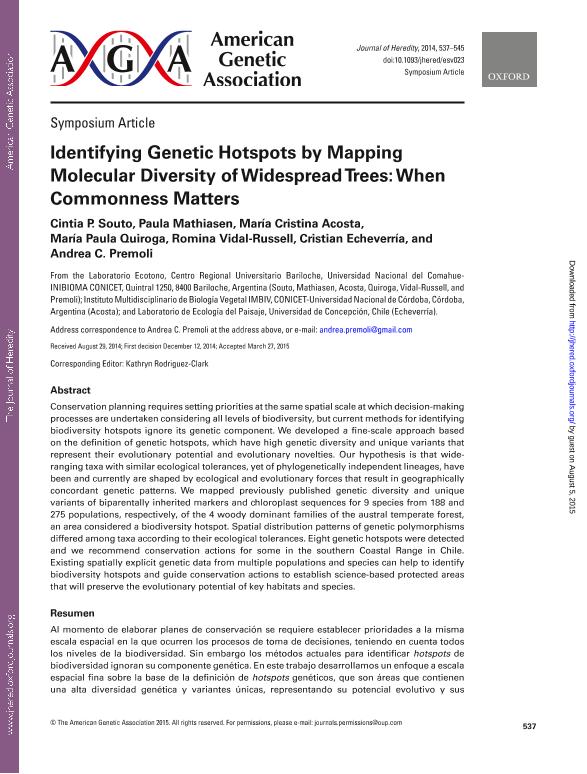Artículo
Conservation planning requires setting priorities at the same spatial scale at which decision-making processes are undertaken considering all levels of biodiversity, but current methods for identifying biodiversity hotspots ignore its genetic component. We developed a fine-scale approach based on the definition of genetic hotspots, which have high genetic diversity and unique variants that represent their evolutionary potential and evolutionary novelties. Our hypothesis is that wideranging taxa with similar ecological tolerances, yet of phylogenetically independent lineages, have been and currently are shaped by ecological and evolutionary forces that result in geographically concordant genetic patterns. We mapped previously published genetic diversity and unique variants of biparentally inherited markers and chloroplast sequences for 9 species from 188 and 275 populations, respectively, of the 4 woody dominant families of the austral temperate forest, an area considered a biodiversity hotspot. Spatial distribution patterns of genetic polymorphisms differed among taxa according to their ecological tolerances. Eight genetic hotspots were detected and we recommend conservation actions for some in the southern Coastal Range in Chile. Existing spatially explicit genetic data from multiple populations and species can help to identify biodiversity hotspots and guide conservation actions to establish science-based protected areas that will preserve the evolutionary potential of key habitats and species. Al momento de elaborar planes de conservación se requiere establecer prioridades a la misma escala espacial en la que ocurren los procesos de toma de decisiones, teniendo en cuenta todos los niveles de la biodiversidad. Sin embargo los métodos actuales para identificar hotspots de biodiversidad ignoran su componente genética. En este trabajo desarrollamos un enfoque a escala espacial fina sobre la base de la definición de hotspots genéticos, que son áreas que contienen una alta diversidad genética y variantes únicas, representando su potencial evolutivo y sus novedades evolutivas. Nuestra hipótesis es que poblaciones de especies de amplia distribución con tolerancias ecológicas similares, aunque pertenecientes a linajes filogenéticamente independientes, han sido y son moldeadas por fuerzas ecológicas y evolutivas que dan lugar a patrones genéticos geográficamente concordantes. Mapeamos datos publicados anteriormente de diversidad genética y variantes únicas en base a marcadores de herencia biparental y secuencias del ADN del cloroplasto de 188 y 275 poblaciones respectivamente, de nueve especies de las cuatro familias leñosas dominantes del bosque templado austral, un área considerada un hotspot de biodiversidad. Los patrones de distribución espacial de los polimorfismos genéticos difieren entre taxones de acuerdo con sus tolerancias ecológicas. Se detectaron ocho hotspots genéticos y recomendamos acciones de conservación para algunos de ellos al sur de la Cordillera de la Costa en Chile. Datos espacialmente explícitos de múltiples poblaciones y especies pueden ayudar a identificar hotspots de biodiversidad y guiar acciones de conservación con una base científica para establecer áreas protegidas que preserven el potencial evolutivo de hábitats y especies clave.
Identifying genetic hotspots by mapping molecular diversity of widespread trees: when commonness matters
Souto, Cintia Paola ; Mathiasen, Paula
; Mathiasen, Paula ; Acosta, María Cristina
; Acosta, María Cristina ; Quiroga, Maria Paula
; Quiroga, Maria Paula ; Vidal Russell, Romina
; Vidal Russell, Romina ; Echeverría, Cristian; Premoli Il'grande, Andrea Cecilia
; Echeverría, Cristian; Premoli Il'grande, Andrea Cecilia
 ; Mathiasen, Paula
; Mathiasen, Paula ; Acosta, María Cristina
; Acosta, María Cristina ; Quiroga, Maria Paula
; Quiroga, Maria Paula ; Vidal Russell, Romina
; Vidal Russell, Romina ; Echeverría, Cristian; Premoli Il'grande, Andrea Cecilia
; Echeverría, Cristian; Premoli Il'grande, Andrea Cecilia
Fecha de publicación:
09/2015
Editorial:
Oxford Univ Press Inc
Revista:
Journal Of Heredity
ISSN:
0022-1503
Idioma:
Inglés
Tipo de recurso:
Artículo publicado
Clasificación temática:
Resumen
Archivos asociados
Licencia
Identificadores
Colecciones
Articulos(INIBIOMA)
Articulos de INST. DE INVEST.EN BIODIVERSIDAD Y MEDIOAMBIENTE
Articulos de INST. DE INVEST.EN BIODIVERSIDAD Y MEDIOAMBIENTE
Citación
Souto, Cintia Paola; Mathiasen, Paula; Acosta, María Cristina; Quiroga, Maria Paula; Vidal Russell, Romina; et al.; Identifying genetic hotspots by mapping molecular diversity of widespread trees: when commonness matters; Oxford Univ Press Inc; Journal Of Heredity; 106; Special; 9-2015; 537–545
Compartir



